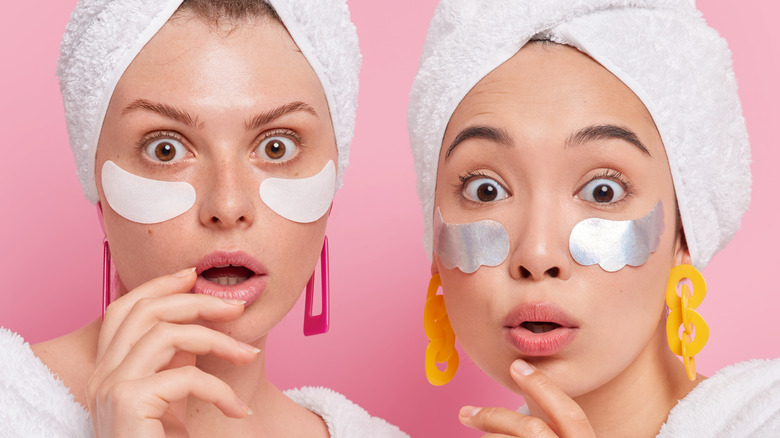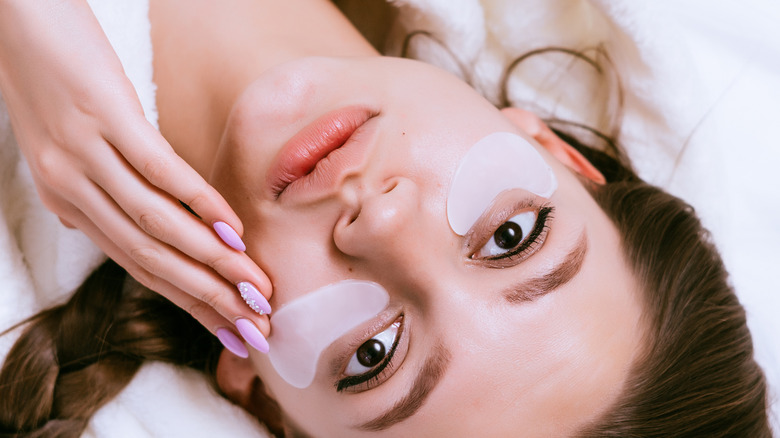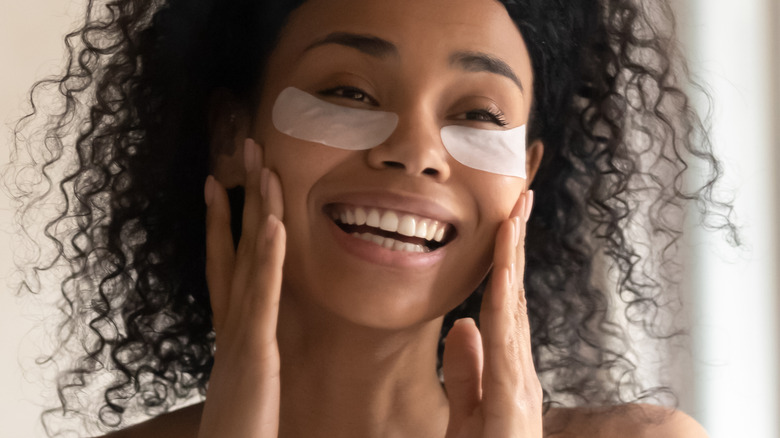Do Wrinkle Patches Actually Work?
Wrinkle patches, often made of skin-safe silicone or adhesive paper, are enjoying tremendous popularity these days, even though they've been around since the 1930s, says dermatologic surgeon Dr. Howard Sobel (via Everyday Health). Just as the name suggests, these pads, packed with skincare ingredients such as vitamins, ginseng, and retinol, are said to aid in reducing the appearance of aging lines. Some popular brands that are all the rage with avid skincare fans include SiO Facelift, Frownies, and Wrinkles Schminkles.
From YouTube to TikTok, beauty influencers are showing themselves sticking patches on their faces and necks overnight for smoother and bouncier skin on their intended areas. These patches can be found in all shapes and sizes and used on different areas of your skin, from your forehead to the area around your mouth.
"Silicone pads like Wrinkles Schminkles are a great non-invasive option for lines coming from facial expressions or from folding and compression of the skin during sleep," board-certified dermatologist Dr. Hadley King told CNN. According to Dr. Hadley King, these pads can keep the skin hydrated and flat, preventing the formation of wrinkles during sleep. Sounds great, doesn't it? But do they really work?
Benefits of wrinkle patches
Many wrinkle patches are silicone-based, featuring medical-grade, hypoallergenic silicone that adheres to the skin gently. They block outside air from entering the skin, prevent repetitive facial movements, and lend a plumping effect in the areas where the patches are applied.
According to Mamamia, wrinkle patches provide the ideal environment for the skin to lock in moisture. The pads contain no harmful chemicals. Instead, various ingredients that contribute to anti-aging effects, such as moisturizing hyaluronic acid or skin-brightening vitamin C, can be found in wrinkle patches. Additionally, the pads also stimulate blood flow to those parts and enhance collagen production.
Thin and pliable silicone patches, as explained by Dermaclara, have been used widely by medical specialists and proved to effectively diminish the discoloration and texture of surgical scars. This non-invasive technique, according to the Dermatology Times, can aid in treating scars and stretch marks. Lending support to this evidence, blogger Alexis Rochester shared that she found her eye area much plumper and youthful-looking after 15 uses of wrinkle patches.
These patches make an excellent substitute for sheet masks that you can wear overnight. However, these pads are nothing like Botox or fillers when it comes to correcting wrinkles.
Wrinkle patches can give you short-term results
In general, wrinkle patches can deliver skincare ingredients to your wrinkle-prone areas while you're sleeping and give you smoother skin. While they are safe and effective in treating wrinkles to a certain degree, they are barely a new holy grail of anti-aging due to their non-invasive nature.
According to aesthetic doctor Dr. Terry Loong, wrinkle patches deliver only short-term and limited results compared to injectables such as Botox, which give you quick, visible improvements by paralyzing your facial muscles temporarily to smooth out wrinkles (via Grazia Daily). What wrinkle patches do well is to train your skin to stay put and promote the production of collagen. That said, neither Botox nor wrinkle patches can guarantee permanent effects, and deeper-set wrinkles will take a longer time to see noticeable results.
Besides, those with sensitive skin should consult their dermatologist before using these patches because some consist of ingredients that can be potentially irritating to the skin, dermatologist Dr. Caroline Robinson told CNN.
Wrapping up, you can think of wrinkle patches as a preventative measure against aging and a pain-free, more affordable alternative to Botox. Nonetheless, you might need to use these patches consistently to maintain results.


